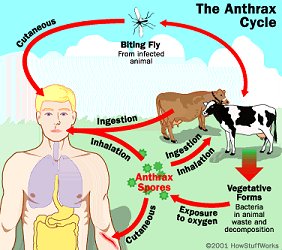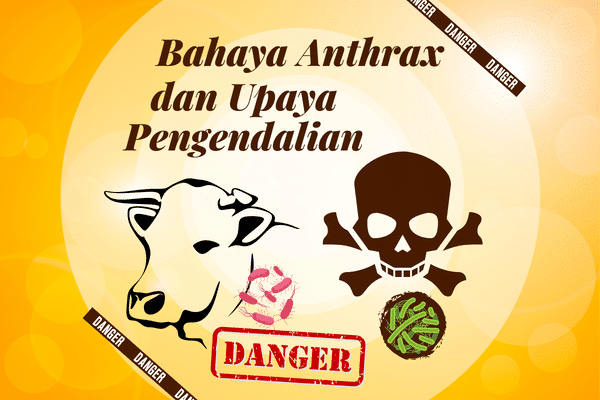What is anthrax? And how is it addressed?
Anthrax is a disease that may sound unfamiliar to some people but has a long history in the field of medicine. Anthrax is a deadly disease that can affect various types of animals, including livestock such as cattle. In this article, we will explore more about anthrax, including its impact on cattle, symptoms, transmission, and control efforts. This information is based on knowledge in the field of Biology and various reliable reference sources.
What is Anthrax?
Anthrax, also known as "charbon" or "milzbrand," is an infectious disease caused by the bacterium Bacillus anthracis. The term "anthrax" is used because of the appearance of black-colored skin lesions resulting from cutaneous anthrax. This bacterium has unique properties and plays a significant role in microbiology studies. It can form spores that are highly resistant to environmental conditions. These spores can survive in the soil and organic matter for a long time. When cattle are exposed to anthrax spores, the bacteria can become active and start multiplying, producing harmful toxins.

How Does Bacillus anthracis Work?
Bacillus anthracis, the bacterium causing anthrax, has unique and complex properties in its mechanism of action. Here is a general overview of how Bacillus anthracis works:
- Penetration and Colonization:
Bacillus anthracis can enter the human or animal body through three main routes: the skin, respiratory system, or gastrointestinal tract. When bacterial spores enter the body, they exist in a dormant (inactive) form and are resistant to harsh environmental conditions. These spores will move to deeper tissues and start activating when favorable conditions are available. - Proliferation and Toxin Release:
Once Bacillus anthracis spores are activated, the bacteria will start multiplying within the body. They will produce and release highly dangerous toxins consisting of three main components: edema toxin, lethal toxin, and protective antigen.- Edema Toxin: Edema toxin stimulates the excessive production of cyclic adenosine monophosphate (cAMP) in body cells. This leads to increased blood flow, damage to blood vessels, tissue swelling, and inhibition of the immune system's function.
- Lethal Toxin: Lethal toxin is an enzyme that disrupts the signaling molecules regulating the body's immune response and hampers the body's defense against infection. This can cause severe inflammation and tissue damage.
- Protective Antigen: Protective antigen helps shield Bacillus anthracis from the immune response and facilitates the spread of bacteria to other tissues in the body.
- Impact on the Body:
The toxins produced by Bacillus anthracis have destructive effects on the body. They can cause inflammation, cell and tissue damage, disruptions in blood flow, and organ dysfunction. This can result in severe symptoms and the potential for death if left untreated. - Sporulation and Dissemination:
During severe infection or after the host's death, Bacillus anthracis can form long-lasting spores. These spores can be released into the environment through infected tissues or the decomposition of dead bodies. The released spores can persist in the soil or organic matter and become a source of infection for animals or humans in the future.
What are the Symptoms of Anthrax in Humans?
Anthrax most commonly affects wild and domesticated herbivores. The disease is zoonotic, meaning it can be transmitted from animals to humans but not between humans.
The symptoms and signs of anthrax in humans can vary depending on the form of infection. Here are the common symptoms associated with each form of anthrax infection:
- Cutaneous Anthrax:
- Skin lesions that appear as red bumps that develop into ulcers with pus formation in the center.
- The ulcers are usually painless but can become painful and itchy.
- The lesions can develop into dry scabs and form a black, deep crust.
- Inhalational Anthrax:
- Initially, mild flu-like symptoms, including fever, chills, headache, and fatigue.
- After a few days, more severe respiratory symptoms occur, such as cough with phlegm, shortness of breath, chest pain, and dizziness.
- The infection can progress to severe pneumonia or bloodstream infection leading to septic shock.
- Gastrointestinal Anthrax:
- Early symptoms include nausea, vomiting, fever, abdominal pain, and bloody diarrhea.
- This condition can progress to severe intestinal inflammation, internal bleeding, and shock.
It is important to note that these symptoms may not always be specific to anthrax and can resemble other diseases.
How is Anthrax Spread and Transmitted?
The spread and transmission of anthrax can occur through several different routes.
Environmental Spread:
Bacillus anthracis, the bacterium causing anthrax, can form spores that are resistant to harsh environmental conditions. These spores can be found in the soil and organic matter such as feathers, hair, or bones of animals that have died from anthrax. If activities like farming, construction, or excavation disturb the soil or these materials, anthrax spores can be disrupted and released into the air.
Transmission through Livestock:
Livestock, such as cattle, can become infected with anthrax through consuming feed or water contaminated with Bacillus anthracis spores. Cattle that ingest grass or food contaminated with anthrax spores can become infected and serve as a source of further transmission. Additionally, cattle can also become infected through contact with other infected animals or with the contaminated environment.
Transmission through Animal Products:
Humans can be infected with anthrax through consuming contaminated animal products, such as meat or dairy products from infected livestock. Inadequate processing and preservation of infected animal products can also serve as a source of anthrax transmission.
Direct Contact Transmission:
Direct contact with infected animals, both live and dead, can also lead to the transmission of this disease. Touching the skin, blood, or tissues of infected animals can allow the bacteria to enter the human body through wounds, scratches, or abrasions on the skin.
Transmission in Humans:
Humans can be infected with anthrax through three main routes:
Cutaneous Anthrax:
Transmission occurs through direct contact with anthrax spores on open wounds or skin abrasions.
Inhalational Anthrax:
Transmission occurs through inhalation of anthrax spores present in contaminated air.
Gastrointestinal Anthrax:
Transmission occurs through consuming food contaminated with anthrax spores.
It is important to note that anthrax does not spread directly from person to person (except in rare cases involving allograft transmission, such as organ transplantation). However, the potential dissemination of anthrax spores in the environment or through animal products can pose risks to the community.

Impact on Cattle Livestock:
Cattle are highly susceptible to anthrax infection. They can become infected through direct exposure to anthrax spores in the environment, including through contaminated food or water. Anthrax infection in cattle can cause symptoms such as high fever, fatigue, reduced appetite, difficulty breathing, and sometimes bleeding. Death can occur shortly after the onset of symptoms.
How is Anthrax Transmitted in Cattle?
Anthrax transmission in cattle occurs when they consume or inhale anthrax spores or become exposed through wounds or skin damage. Cattle can also become infected through contact with animals affected by anthrax, such as dead livestock. Additionally, insects like flies and blood-feeding insects can also serve as vectors in the transmission of anthrax in cattle.
Efforts to Control Anthrax in Cattle Livestock:
Controlling anthrax in cattle livestock is crucial to prevent the spread of the disease to humans and protect the cattle population. Some control efforts include:
- Vaccination:
Vaccines are available for the prevention of anthrax in humans and animals. Vaccination of livestock can help reduce the risk of disease transmission to humans. - Animal Surveillance:
Routine monitoring of livestock health, detecting anthrax cases, and taking prompt action to control its spread. - Hygiene and Sterilization:
Maintaining environmental cleanliness, including proper waste management, and ensuring the sterilization of equipment used in high-risk industries. - Worker Protection:
Providing appropriate training and protection for workers in industries associated with the risk of anthrax, including the use of personal protective equipment. - Public Education:
Educating the public about the threat of anthrax, its symptoms, transmission, and preventive measures that can be taken to avoid infection.
Efforts to Control Anthrax in Cattle Livestock:
Controlling anthrax in cattle livestock is crucial to prevent the spread of the disease to humans and protect the cattle population. Some control efforts include:
- Vaccination:
Anthrax vaccines are available and commonly administered to livestock, including cattle. Vaccination can help protect cattle from infection and reduce the risk of disease transmission to humans. - Animal Surveillance:
Early detection and monitoring of cattle health are essential. Infected cattle should be isolated and given proper care. Unusual deaths in livestock need to be promptly reported to local animal health authorities. - Carcass Handling:
Carcasses suspected to be infected with anthrax should be handled with caution and proper procedures. Carcasses should be disposed of safely and destroyed in compliance with applicable sanitation guidelines and regulations. - Hygiene and Sterilization:
Maintaining cleanliness in cattle pens and rearing areas is crucial. Proper management of livestock waste, including processing and disposal, can help prevent the spread of anthrax spores. - Educating Farmers:
Providing education to farmers about the threat of anthrax, its symptoms, and preventive measures is essential. Farmers need to be knowledgeable and informed about the signs of anthrax in cattle and the actions to be taken if there is suspected infection.
Conclusion:
Anthrax is a deadly disease that can affect cattle livestock. The spread of anthrax in cattle can have serious implications for the cattle population and pose risks of transmission to humans. Therefore, it is important to take appropriate preventive and control measures, including vaccination, animal surveillance, proper carcass handling, maintaining hygiene and sterilization, and providing education to farmers. Public education also plays a key role in efforts to prevent and control this disease.
Referensi:
- Centers for Disease Control and Prevention. (2021). Anthrax. Diakses dari: https://www.cdc.gov/anthrax/index.html
- World Health Organization. (2019). Anthrax. Diakses dari: https://www.who.int/en/news-room/fact-sheets/detail/anthrax
- Dixon, T. C., Meselson, M., Guillemin, J., & Hanna, P. C. (1999). Anthrax. New England Journal of Medicine, 341(11), 815-826.







